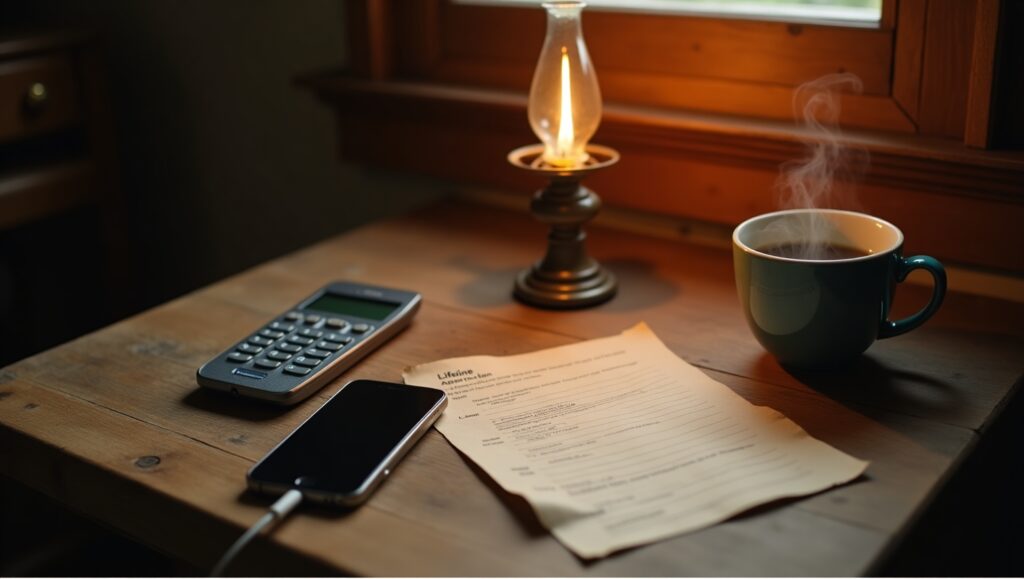When we first heard about the free government phone program in Alaska, we were skeptical. Could it really be that easy to get a phone without spending much? Living in Alaska has its challenges, like long distances and spotty service, but we decided to try the Alaska Lifeline program.
The application process had its quirks, but it turned out to be a lifesaver. We discovered that the program genuinely helps low-income families stay connected. If you’re considering applying for a free phone in Alaska, keep reading to find out what you need to know.
Key Takeaways
- The Alaska Lifeline program provides free or discounted phone service to eligible low-income residents, including free smartphones and data plans.
- Applying requires proof of income or participation in qualifying assistance programs, along with a valid ID and physical address details.
- Recertification is necessary annually to maintain benefits, and only one Lifeline benefit is allowed per household.
What the Alaska Lifeline Program Offers
We didn’t expect much at first. Just needed a working phone and maybe a few gigabytes of data. What we got from the Alaska Lifeline program surprised us—real help. This is the main program offering a free government phone in Alaska, and it’s backed federally, not some small-time local deal. It covers free smartphone Alaska delivery, monthly service plans, and even ties into the affordable connectivity program Alaska if you want cheap internet too.
Phones aren’t a luxury here. With distances so wide and towns far-flung, even basic communication can feel out of reach. For us, the Alaska low income phone program meant not missing medical calls, job callbacks, or emergencies. They mailed the phone—no store visit, no fees.
Lifeline Phone Service Alaska: What’s Included?
Here’s what our package from the Lifeline phone providers Alaska looked like:
- A free Android smartphone (ours came with 32GB internal storage)
- Unlimited texting
- Around 1,000 minutes monthly
- 4GB of mobile data, sometimes more during promos
- Voicemail and emergency call access
No contract. No setup fee. No credit check. If you’re wondering what the free phone and data Alaska deal actually gets you—it’s this. Just enough to function, to connect, to keep moving.
We also saw options through the Alaska ACP program, which adds broadband discounts. Pairing both helps families needing more than just phone service.
Who Qualifies for a Free Government Phone in Alaska?
We didn’t know if we’d qualify. But the Lifeline eligibility Alaska system is clearer once you dig. You either qualify through income or through certain assistance programs. We went the Medicaid route.
Income Limits and Qualifying Programs
The threshold is 135% of the Federal Poverty Guidelines for Alaska. For one person in 2025, that’s about $26,393. That number goes up with more household members. Here’s a quick snapshot:
- 1 person – $26,393
- 2 people – $35,632
- 3 people – $44,871
- 4 people – $54,110
You’re also eligible if you’re on:
- Medicaid (like us)
- SNAP or food stamps
- Supplemental Security Income (SSI)
- Federal Public Housing Assistance
- Veterans Pension
- Tribal TANF, Bureau of Indian Affairs GA
- LIHEAP, Pell Grant, WIC, Section 8
The free phone for SNAP recipients Alaska offer runs under the same deal as ours.
Special Considerations for Alaska
Alaska’s a bit different. For Lifeline, large parts of the state are considered Tribal Lands. If you live outside major hubs like Anchorage or Fairbanks, you may need to submit exact physical address info—sometimes latitude and longitude coordinates. That part felt odd but necessary. We had to double-check our rural mailbox didn’t count as a valid address.
How We Applied for the Alaska Free Phone Program
The government phone application Alaska steps weren’t hard, but you gotta be exact. We learned quickly that small mistakes—wrong birthdate, fuzzy ID scan—can delay things.
Step 1: Gather Documentation
We needed:
- Medicaid award letter (dated within the last 12 months)
- State ID (not expired)
- Full physical address, no PO boxes
We took photos with our old phone and uploaded them as JPGs. The system prefers clear images, less than 5MB.
Step 2: Complete the Application
We used the USAC National Verifier at lifelinesupport.org. The Alaska free phone online application only took about 20 minutes. For us, Medicaid auto-verified, which saved days.
Folks without automatic eligibility can still apply by mail, but we’d suggest online. It’s just quicker.
Step 3: Wait for Approval and Activate Service
Our approval email came in 6 business days. From there, we picked one of several Alaska Lifeline phone providers. We went with one that had decent service coverage and shipped our phone in 3 days.
The Alaska free phone activation instructions were simple. Insert the SIM, charge the phone, and make your first call. Ours connected right away.
What to Expect After You Get Your Free Phone
Credits: Best Parameters
Our service kicked in fast. Within an hour of unboxing, we were texting family, checking bus schedules, looking up grocery store hours.
Monthly Usage and Plans
Every month, our Lifeline phone plans Alaska reset. We got a message when new minutes and data dropped in. We could:
- Send unlimited texts
- Call anywhere in the U.S.
- Use up to 4GB for apps, browsing, or calls
We didn’t stream a lot, but YouTube worked in low res. Google Maps loaded fine.
Customer Support and Service Areas
We called customer support twice—once for a voicemail issue, once to change our address. The reps were polite, didn’t transfer us around.
Coverage in our town was solid. If you live near the coast or farther north, check the Alaska free phone service areas maps online. Some providers do better in rural zones.
Recertification Requirements
One thing we didn’t expect—Lifeline discount Alaska rules say you have to recertify every year. They try to do this automatically with your benefit info. But if that doesn’t work, they’ll email or mail you.
We got a notice last December and had to reupload our Medicaid proof again. Took 10 minutes.
Tips from Our Experience Applying for a Free Government Phone in Alaska
What helped us most was getting organized early. Here’s our advice:
- Keep your Medicaid letter or other program documents somewhere easy to grab
- Your address must match your ID, especially for Alaska free phone documentation
- Always apply online—faster, easier, better tracking
- Once approved, go to your chosen Lifeline phone support Alaska provider’s website right away
- Use the phone at least once a month, or the system may think you abandoned it
- Watch for recertification emails—don’t miss the deadline
And if you’re applying as a veteran, senior, or from a tribal area, know there are extra supports in place. The Alaska free phone for seniors, disabled, or tribal members programs can come with boosted plans or priority processing.
We didn’t expect much. But now we can’t imagine being without it.
Additional Programs That Complement Lifeline in Alaska
We learned pretty quick that Lifeline alone wasn’t enough, especially when winter hits and the signal drops out for days. Our group found ourselves needing more than just a phone—we needed reliable internet, too. That’s where the Affordable Connectivity Program Alaska (ACP) came in. It works alongside Lifeline, filling in the gaps.
We saw real savings—30offourinternetbill,andoneofusontriballandgot30 off our internet bill, and one of us on tribal land got 30offourinternetbill,andoneofusontriballandgot75 off. That covered groceries for some months. Applying was simple, but we had to do it ourselves. Double-check every detail—one wrong letter and they’ll hold up your approval.
Who Else Can Benefit from Alaska’s Free Phone Programs?
We met all kinds during the signup clinics. There were seniors, veterans, young parents, folks living with disabilities. One man used his phone to apply for three jobs in one week. Another woman used hers to check on her son up in Kotzebue, way past the road system.
If you’re in any of these programs, there’s a strong chance you qualify:
- SNAP (food stamps)
- WIC (Women, Infants, and Children)
- TANF (Temporary Assistance for Needy Families)
- SSI (Supplemental Security Income)
- Federal Public Housing Assistance
- Veterans Pension or Survivor Benefits
- Tribal programs like Tribal TANF or Head Start
We also heard from students using Pell Grants and families with kids getting free school lunch. That’s a wide safety net, and it needs to be. Alaska government phone service is often the only connection when you’re outside town.
What We Wish We Knew Before Applying
At first, the Alaska free phone application seemed easy. But we hit snags.
- You need a physical street address. P.O. boxes don’t cut it. That was tough for folks in tents, cabins, or trailers.
- Only one Lifeline phone service Alaska line per household. That meant we had to pick who needed it most.
- They ask for proof—pay stubs, benefit letters, or tax returns. We didn’t gather those ahead of time. Wish we had.
- Eligibility isn’t up to the phone companies. The national verifier (USAC) decides. That part confused us. We kept calling the provider, but they couldn’t help till we got verified.
Then there’s recertification. They send a letter or a text once a year. Miss it, and you’re disconnected. No extra notice. It happened to our neighbor, and she had to start all over.
Staying Connected Without Breaking the Bank

We started seeing our phones different. They weren’t just for scrolling. They were flood alerts, heating system monitors, even how we scheduled ferry crossings.
Some towns get 4G. Others drop to 2G—or nothing at all. That’s why we checked coverage maps before picking a provider. But even then, we’d ask neighbors which company worked best. The Alaska free phone service providers list shows what’s available by ZIP code, but it’s not always accurate.
For us, a working phone wasn’t a luxury. It meant calling 911 in a whiteout. Calling our kids when the plane landed. Checking prices at the general store when fuel went up again.
Practical Advice for Applicants
Here’s what we learned:
- Check if you’re eligible through income or participation in programs.
- Collect all your documents first: ID, benefit letters, proof of address.
- The online Alaska free phone application is quicker than mailing.
- Info has to match exactly—spelling, dates, everything.
- Find a Lifeline phone provider Alaska that covers your area.
- Use the phone every 30 days or it might get turned off.
- Mark your recert date on the calendar. Early is better.
- Questions? Call Lifeline phone support Alaska at 1-800-234-9473.
We told our cousins, our neighbors, even strangers in the line at the food bank. This benefit is there. You just gotta follow the steps, stay on top of it, and it’ll stay with you.
FAQ
What’s the Alaska Lifeline program and how do I apply for a free government phone Alaska?
The Alaska Lifeline program gives free phone help to people with low income. If you want to apply for a free phone Alaska, you first need to meet Lifeline eligibility Alaska. You can qualify if you get help like Medicaid, SNAP, or SSI. The Lifeline phone Alaska application is easy—you can apply online or mail it in. The government phone application Alaska form will ask for proof, like pay stubs or benefit letters.
Who can qualify for Alaska free phone service and what proof do I need?
To get free phone Alaska qualification, you need to show low income or be in a program like Medicaid or TANF. The Alaska free phone eligibility criteria mean you need to show proof—like tax forms, pay stubs, or letters from programs. Alaska free phone documentation must be official. This is true for Lifeline phone service Alaska and the affordable connectivity program Alaska too. Always check the Alaska free phone proof of eligibility list.
What’s the difference between Lifeline and the Alaska ACP program?
The Alaska Lifeline program gives free phone service. The Alaska ACP program helps with the internet. You can use both if you qualify. The Alaska low income phone program covers calls and texts. Alaska free phone and data come with ACP. To get started, apply for a free phone Alaska by filling out forms for each. Lifeline phone plans Alaska are different depending on where you live and which provider you choose.
How do I apply for Alaska free phone online application if I don’t have internet?
If you don’t have internet, you can still fill out the Alaska free phone online application at a library or help center. Some places offer Alaska free phone enrollment help in person. The Alaska free phone application process is quick—just show proof and fill in your info. After that, some people get Alaska free smartphone mail delivery. The Alaska Lifeline phone providers list will show who you can apply with.
Conclusion
Getting a free government phone in Alaska wasn’t just about saving money—it helped us stay close to the people we love. Through the Alaska Lifeline program, we found a way to stay connected, feel safer, and worry less.
In a state as big and remote as ours, that really matters. If you’re thinking about it, we hope our story gives you the push to try. Click here to apply and stay connected with Lifeline. Free Government Phone by State makes it easy to find out what programs are available where you live.


